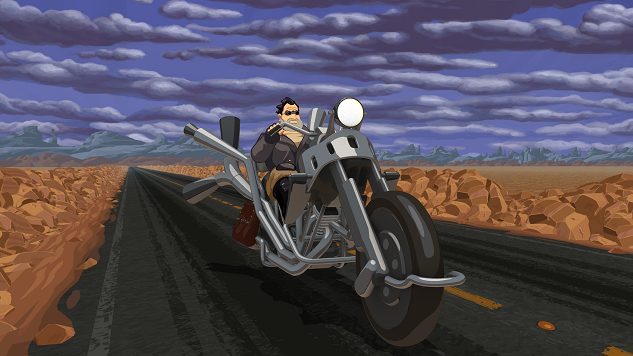Full Throttle Remastered Is a Commentary on the Fate of Adventure Games

In a way, Full Throttle is as much as commentary on itself as anything else. Released in the heart of the 1990s, when “adventure game” was a phrase nearly synonymous with LucasArts and Sierra, Full Throttle tells a story of a subculture turned mainstream, outlaws turning corporate, and a dystopic society peppered with humor and generally well-written characters.
Twenty years on down the road, many of the motifs of the game (corporate takeover, outsourcing, a subculture lost to the ages) feel like a pointed critique of the way that adventure games fell by the wayside in popular gaming culture. In the past few years, we’ve seen the genre rising from the ashes and back into popular lexicon, with a crop of older-style throwback games made by indie studios, and new types of adventure games from larger studios like Telltale.
The most recent remaster preserves nearly everything from the original that gave it such high marks on release. I’m happy to say that even as a first-time player, the game shines, even if a few segments are showing their age. As you might expect, not all the design choices made in a game from twenty years ago hold up quite as well today.
As with many recent LucasArts remasters by Double Fine, Full Throttle includes a one-button option to switch the art and audio between the original pixel and FMV methods and the updated hand-drawn art for the rerelease. The pixel art and early-3D of the original release has been revamped with a draw-over technique previously seen in the Day of the Tentacle and Grim Fandango remasters of the past few years.
I have mixed thoughts on this. While the new art is undeniably smoother than the pixel stylings of the original game, and certainly adds more detail in times where the pixels were less-coherent, the overall effect feels more generic than I’d appreciate. This is most common in the larger landscape shots, where a clean pixel ratio in the original work gives way to wildly different line thicknesses in the updated art, as shrunken sprites clash with background assets. What was once suggestive is now straightforward, and this isn’t always the most graceful artistic choice.
The revamped 3D in the cinematics also leaves something to be desired. It’s not the worst renewal job, but it does seem to brighten up the tone of some of the visuals, for better and for worse. The original FMVs were muddy and moody, playing up the dystopian feel of the gameworld. The new ones are brighter, slicker and even cartoonish at times, and often feel at odds with the design goals of the original, more primitive renderings. Any remaster is a tight line to walk, and Full Throttle gets it mostly right—I only wish some of the artistic choices were a bit more… bleak. Cleanliness feels out of place in a story about bikers, outlaws, and down and dirty corporate sabotage.
